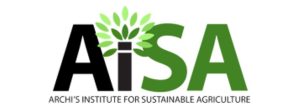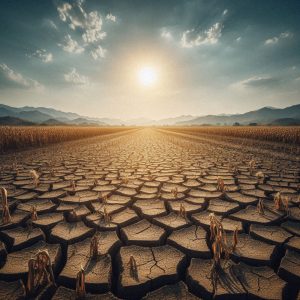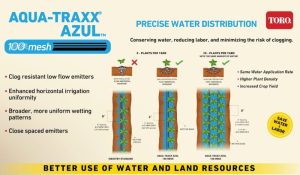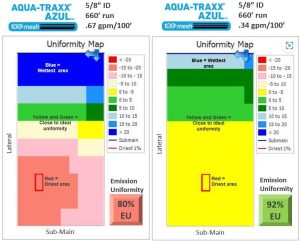
Agricultural water quality and food safety issues are important, and growers are finding that drip irrigation is a valuable tool to help solve their problems.
Drip Irrigation Avoids Runoff – In fruit and vegetable row crop production, significant runoff often occurs during the first couple of weeks of production when sprinklers are used to germinate seed or set transplants. Much of this runoff is wasted and creates water quality problems in surface water supplies or in ground water supplies. Some producers are eliminating the need for sprinklers during the first few weeks of production by paying close attention to soil preparation techniques and drip tape selection to successfully germinate and/or set the crop with drip irrigation system that is typically only used for in-season irrigation. This practice prevents runoff and deep percolation, saves water and reduces sprinkler pipe and movement costs.
Farm Irrigation Utilizing Drip Irrigation May Reduce the Presence of E. Coli – There is evidence that better water management with drip irrigation reduces the incidence of water borne pathogens that threaten food safety. Preliminary research by Dr. Michael Cahn of the University of California in Monterey County has found that strains of generic, non-pathogenic E. Coli survived up to two weeks in runoff water from sprinkler irrigated fields, while no E. Coli was detected in drip irrigated fields which had no runoff.
Pressure Compensation Improves Drip Irrigation Application Uniformity – A UCCE hands-on workshop titled, “Drip Irrigation on Slopes: Achieving Uniformity” was held earlier this year at the Kitayama Ranch in Watsonville for growers, foremen, and irrigators. They were shown how to collect and process field data to determine irrigation application uniformity, and also show how important pressure regulation is on slopes. The workers determined in a side by side comparison that a non-pressure compensating tape performed at 87.6% uniformity, while a pressure compensating tape performed at 92.3% uniformity.
Drip Irrigation Application Uniformity Field Test Data, Watsonville, CA – At a UCCE Workshop, workers determined in a side-by-side comparison that a non-pressure compensating tape performed at 87.6% uniformity, while a pressure compensating tape performed at 92.3% uniformity. Both of these uniformity values are considered excellent, but it is noteworthy that product selection alone improved uniformity by over 5%.





